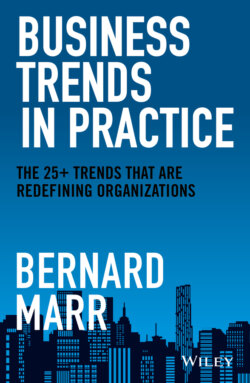Читать книгу Business Trends in Practice - Бернард Марр, Bernard Marr - Страница 27
Trend 6: Digital Trust
ОглавлениеDigital trust can be defined as the confidence users place in organizations to build a secure digital world, where transactions and interactions can take place safely, securely, and easily. Many believe blockchain and distributed ledger technology will play a central role in raising digital trust and making transactions more secure. (When serving as CEO of IBM, Ginni Rometty said, “What the Internet did for communications, I think blockchain will do for trusted transactions.”)10 This technology already exists, but it has some way to go before it's truly accessible for all organizations. That said, advances in more ubiquitous computing, 5G, edge computing, and cloud computing may combine to make blockchain technology more accessible (for example, by harnessing distributed computing power around the world, instead of having entire server farms dedicated to running just one blockchain).
But let's back up a bit. What exactly is blockchain technology? In very simple terms, it's a super-secure way of storing data. Blockchain promises a practical solution to the problem of storing, authenticating, and protecting data, thereby providing a new way to authenticate information, identities, transactions, and more. This makes blockchain an increasingly attractive tool for industries like banking and insurance, but in fact blockchain can be used to provide a super-secure real-time record of pretty much anything: contracts, supply chain information, even physical assets.
To get a little more technical, a blockchain is a form of open, distributed ledger (i.e., a database), where the data is distributed (i.e., duplicated) across many computers and is typically decentralized. This means there's no one central point of attack for hackers to target – hence why blockchain is so secure.
How does it work? Records in a blockchain are called “blocks” and each block has a time and date stamp, noting when the record was created or updated. Each block is linked to the previous block, thus forming the “chain.” The chain itself can be public (Bitcoin is a prime example of a public blockchain) or private (like a banking blockchain).
What about the difference between blockchain and distributed ledger technology? Although I use “blockchain” as a catchall term here, strictly speaking, the two terms aren't quite interchangeable. A good way to sum up the difference is this: a blockchain is typically open and permissionless, while a distributed ledger tends to be permissioned. Blockchains are generally public, creating a truly decentralized, democratic system where no one body or person is “in charge” (Bitcoin being the perfect example). A distributed ledger, on the other hand, could be private, meaning access is restricted by one centralized body (say, an organization). So a distributed ledger isn't necessarily decentralized and democratic, but it is still distributed and generally far more secure than traditional databases.
Blockchain and distributed ledger technology brings many advantages for businesses: securing data, removing intermediaries, increasing transparency, and supporting super-secure, frictionless, real-time transactions. But there are challenges to overcome – chief of which is how to implement this technology within the constraints of an organization built on legacy technology. The answer may lie in partnering with the many new innovators and entrepreneurs who are making real headway in the blockchain space. According to Deloitte, 45 percent of emerging disrupters have already brought blockchain to production, compared to less than 25 percent of enterprise businesses.11 In other words, fully harnessing blockchain technology may require a complete rethink of operations, rather than trying to bolt this revolutionary technology onto existing systems.
And while we're on the subject of rethinking business processes, we can't ignore the potential for 3D printing to overhaul manufacturing.
